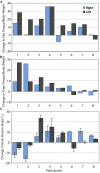Can strength training predictably improve gait kinematics? A pilot study on the effects of hip and knee extensor strengthening on lower-extremity alignment in cerebral palsy
- PMID: 20022999
- PMCID: PMC2816027
- DOI: 10.2522/ptj.20090062
Can strength training predictably improve gait kinematics? A pilot study on the effects of hip and knee extensor strengthening on lower-extremity alignment in cerebral palsy
Abstract
Background: Computer simulations have demonstrated that excessive hip and knee flexion during gait, as frequently seen in ambulatory children with cerebral palsy (CP), can reduce the ability of muscles to provide antigravity support and increase the tendency of hip muscles to internally rotate the thigh. These findings suggest that therapies for improving upright posture during gait also may reduce excessive internal rotation.
Objective: The goal of this study was to determine whether strength training can diminish the degree of crouched, internally rotated gait in children with spastic diplegic CP.
Design: This was a pilot prospective clinical trial.
Methods: Eight children with CP participated in an 8-week progressive resistance exercise program, with 3-dimensional gait analysis and isokinetic testing performed before and after the program. Secondary measures included passive range of motion, the Ashworth Scale, and the PedsQL CP Module. To identify factors that may have influenced outcome, individual and subgroup data were examined for patterns of change within and across variables.
Results: Strength (force-generating capacity) increased significantly in the left hip extensors, with smaller, nonsignificant mean increases in the other 3 extensor muscle groups, yet kinematic and functional outcomes were inconsistent. The first reported subject-specific computer simulations of crouch gait were created for one child who showed substantial benefit to examine the factors that may have contributed to this outcome.
Limitations: The sample was small, with wide variability in outcomes.
Conclusions: Strength training may improve walking function and alignment in some patients for whom weakness is a major contributor to their gait deficits. However, in other patients, it may produce no change or even undesired outcomes. Given the variability of outcomes in this and other strengthening studies in CP, analytical approaches to determine the sources of variability are needed to better identify those individuals who are most likely to benefit from strengthening.
Figures





Similar articles
-
Characteristics associated with improved knee extension after strength training for individuals with cerebral palsy and crouch gait.J Pediatr Rehabil Med. 2012;5(2):99-106. doi: 10.3233/PRM-2012-0201. J Pediatr Rehabil Med. 2012. PMID: 22699100 Free PMC article. Review.
-
Crouched postures reduce the capacity of muscles to extend the hip and knee during the single-limb stance phase of gait.J Biomech. 2008;41(5):960-7. doi: 10.1016/j.jbiomech.2008.01.002. Epub 2008 Mar 4. J Biomech. 2008. PMID: 18291404 Free PMC article.
-
Gait improvements by assisting hip movements with the robot in children with cerebral palsy: a pilot randomized controlled trial.J Neuroeng Rehabil. 2020 Jul 3;17(1):87. doi: 10.1186/s12984-020-00712-3. J Neuroeng Rehabil. 2020. PMID: 32620131 Free PMC article. Clinical Trial.
-
Do the hamstrings and adductors contribute to excessive internal rotation of the hip in persons with cerebral palsy?Gait Posture. 2000 Jun;11(3):181-90. doi: 10.1016/s0966-6362(00)00046-1. Gait Posture. 2000. PMID: 10802430
-
Artificial Walking Technologies to Improve Gait in Cerebral Palsy: Multichannel Neuromuscular Stimulation.Artif Organs. 2017 Nov;41(11):E233-E239. doi: 10.1111/aor.13058. Artif Organs. 2017. PMID: 29148138 Review.
Cited by
-
A path model for evaluating dosing parameters for children with cerebral palsy.Phys Ther. 2014 Mar;94(3):411-21. doi: 10.2522/ptj.20130022. Epub 2013 Nov 14. Phys Ther. 2014. PMID: 24231231 Free PMC article.
-
The inaccuracy of surface-measured model-derived tibiofemoral kinematics.J Biomech. 2012 Oct 11;45(15):2719-23. doi: 10.1016/j.jbiomech.2012.08.007. Epub 2012 Sep 8. J Biomech. 2012. PMID: 22964018 Free PMC article.
-
Does patella lowering as part of multilevel surgery improve knee kinematics in children with cerebral palsy and crouch gait? A meta-analysis of comparative studies.J Child Orthop. 2023 Dec 14;18(1):13-25. doi: 10.1177/18632521231217542. eCollection 2024 Feb. J Child Orthop. 2023. PMID: 38348440 Free PMC article. Review.
-
Defining feasible bounds on muscle activation in a redundant biomechanical task: practical implications of redundancy.J Biomech. 2013 Apr 26;46(7):1363-8. doi: 10.1016/j.jbiomech.2013.01.020. Epub 2013 Mar 12. J Biomech. 2013. PMID: 23489436 Free PMC article.
-
Association of the Number of Teeth With Physical Function and Length of Hospital Stay After Hip Fracture Surgery: A Prospective Observational Study at a Tertiary Hospital in Japan.Cureus. 2023 Oct 18;15(10):e47297. doi: 10.7759/cureus.47297. eCollection 2023 Oct. Cureus. 2023. PMID: 38022003 Free PMC article.
References
-
- Hirtz D, Thurman DJ, Gwinn-Hardy K, et al. How common are the “common” neurologic disorders? Neurology 2007;68:326–337 - PubMed
-
- Sussman M. ed. The Diplegic Child Evaluation and Management Rosemont, IL: American Academy of Orthopaedic Surgeons; 1992
-
- Perry J. Determinants of muscle function in the spastic lower extremity. Clin Orthop Relat Res 1993;(288):10–26 - PubMed
-
- Arnold AS, Anderson FC, Pandy MG, Delp SL. Muscular contributions to hip and knee extension during the single limb stance phase of normal gait: a framework for investigating the causes of crouch gait. J Biomech 2005;38:2181–2189 - PubMed
Publication types
MeSH terms
Grants and funding
LinkOut - more resources
Full Text Sources
Medical
Miscellaneous

